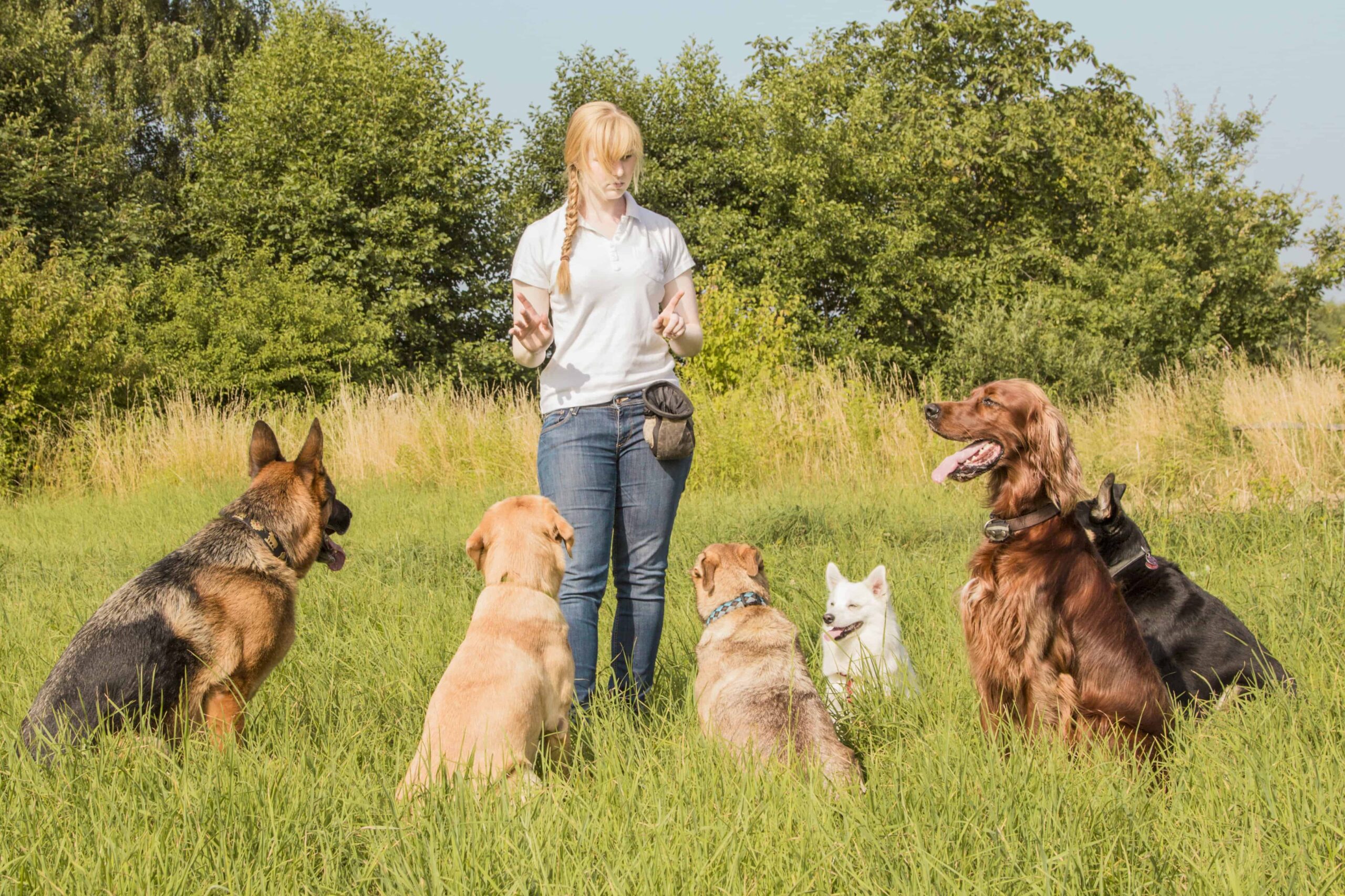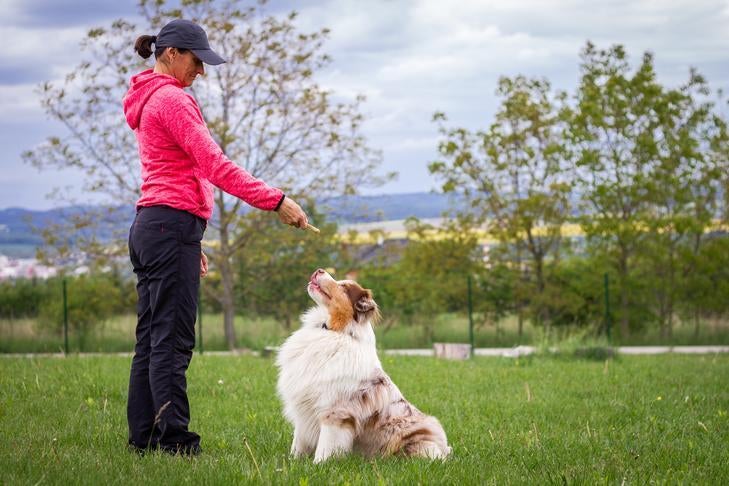Recognizing Dog Body Language During Dog Training
Recognizing Dog Body Language During Dog Training
Blog Article
Necessary Tips for Effective Dog Training: A Guide for Pet Dog Owners
Effective pet training is a diverse procedure that calls for a tactical technique customized to both the pet's temperament and the owner's objectives. Key parts such as establishing consistent commands, employing positive reinforcement, and assisting in very early socializing play critical duties in promoting a well-adjusted canine companion. Many animal proprietors run into obstacles that can prevent progression, leading to aggravation and uncertainty. Recognizing how to navigate these barriers can considerably enhance the training experience, ultimately changing the connection in between owner and pet. What are the crucial approaches that can be used to ensure success in this venture?
Recognizing Dog Behavior
Understanding pet dog habits is essential for effective training and cultivating an unified partnership in between dogs and their proprietors. Dogs interact largely with body movement, articulations, and actions, making it essential for proprietors to analyze these signals accurately. Recognizing a pet's posture, tail position, and ear positioning can provide understandings right into its mood. For example, a wagging tail does not always show joy; it can also indicate excitement or anxiousness.

Socialization plays a considerable function in pet dog habits; exposure to numerous atmospheres, individuals, and other animals can substantially affect a canine's temperament. Furthermore, elements such as breed features and individual personality need to assist training techniques, as some breeds may have particular behavior attributes that require tailored approaches. By comprehending these elements, proprietors can create an encouraging setting that motivates favorable habits, leading to effective training results and a deeper bond with their family pets.
Establishing Consistent Commands
Effective interaction with your canine starts with developing consistent commands. This fundamental element of training is crucial for cultivating understanding in between you and your animal. Uniformity in the commands you use makes certain that your dog can dependably connect details words or expressions with the preferred actions.
When selecting commands, pick clear, distinct words that are simple to say and separate from each other. Stay clear of using similar-sounding commands that may perplex your canine. Utilizing "rest" and "remain" is appropriate, however "rest" and "struck" can lead to misunderstandings.
In addition, keep the exact same tone and quantity for each and every command. Dogs are sensitive to vocal cues, so varying your tone can produce complication.
It is equally essential to guarantee that all member of the family get on the very same page regarding the commands utilized. A united front in command use will certainly stop blended signals and strengthen the discovering process.
Positive Reinforcement Methods
The power of positive support in pet dog training lies in its capacity to encourage preferred behaviors via incentives and appreciation. This method is based in the concept that habits adhered to by favorable outcomes are much more most likely to be duplicated. By including positive support into your training regimen, you can properly form your dog's habits in a constructive way.
To implement favorable reinforcement, it's important to identify what encourages your dog, whether it be deals with, toys, or spoken praise. When your pet carries out a wanted action, such as remaining on command, right away compensate them with a treat or love. This organization in between the command and the positive end result strengthens their understanding.
It's critical to timing the rewards appropriately; providing the support within seconds of the preferred actions helps your dog make the link (dog training). Additionally, uniformity is vital-- guarantee that all household members make use of the same commands and benefit systems to prevent complication

Gradually, you can website link minimize the regularity you could look here of deals with as your pet learns the actions, transitioning to praise or periodic incentives. This method not only promotes a solid bond between you and your dog however likewise advertises a favorable learning setting, making educating an enjoyable experience for both.
Socialization and Interaction
Constantly subjecting your pet to a selection of settings, individuals, and other animals is important for their social advancement. Socializing needs to start early, ideally throughout the critical window of 3 to 14 weeks, when pups are most responsive to new experiences. Older dogs can additionally benefit from ongoing socialization initiatives.
Present your dog to various setups, such as parks, pet-friendly shops, and urban locations. This exposure aids them adapt to numerous stimuli, decreasing anxiety and fear actions. Urge positive interactions with various other canines and individuals, ensuring that these experiences are safe and regulated to foster self-confidence.
Utilize structured playdates with genteel canines, as this can boost your dog's social skills and educate them suitable actions. Obedience courses and training sessions also provide exceptional opportunities for socialization, allowing your canine to communicate with others in a monitored atmosphere.
Screen your pet's body language during communications, as this will help you gauge their convenience level. Slowly boost direct exposure to even more challenging scenarios while making sure that each experience is positive. A well-socialized canine is a lot more likely to display well balanced behavior, making my blog them a pleasure to have in any setting.
Resolving Common Training Obstacles
Every dog owner will come across training challenges at some time, no matter their dog's age or socialization degree. Identifying common problems such as stubbornness, distractions, and fearfulness can aid in establishing reliable approaches for improvement.

Progressively present diversions as the pet comes to be a lot more skilled in commands. Short, frequent training sessions are likewise efficient in maintaining focus.
Fearfulness can prevent a pet's understanding procedure. Progressive desensitization to the source of worry, paired with favorable support, can assist minimize anxiety. Persistence is vital; never force a pet into a situation that triggers distress, as this may aggravate the concern.
Eventually, understanding and addressing these usual difficulties with an organized method will cultivate a much more productive training experience, reinforcing the bond in between dog and owner while promoting effective learning.
Conclusion
In recap, effective canine training relies upon a comprehensive understanding of canine behavior, the facility of consistent commands, and the application of favorable reinforcement methods. Socialization plays an important role in creating well-adjusted animals, while resolving common training obstacles requires patience and versatility. By implementing these necessary strategies, family pet proprietors can promote a strong bond with their dogs and promote preferable actions, eventually bring about an unified relationship between human beings and their canine companions.
Comprehending pet behavior is necessary for effective training and promoting an unified partnership between dogs and their proprietors.Socializing plays a significant function in pet dog actions; direct exposure to different atmospheres, individuals, and various other pets can significantly impact a pet dog's personality.The power of positive reinforcement in dog training lies in its ability to motivate wanted behaviors through rewards and praise. By integrating positive support right into your training routine, you can properly shape your dog's behavior in a constructive manner.
In summary, successful dog training relies on a detailed understanding of canine habits, the facility of regular commands, and the application of positive support strategies.
Report this page